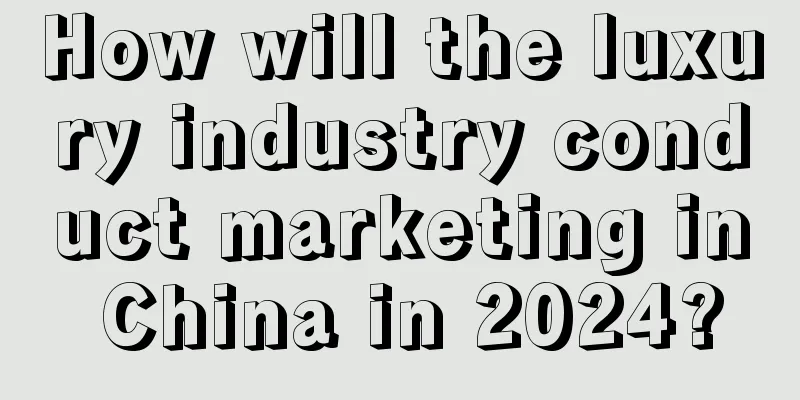How will the luxury industry conduct marketing in China in 2024?

The Chinese market has unleashed a lucrative opportunity for rapid growth in luxury goods, but when brands want to make their mark, they will find that China’s market environment is different from that of other regions, and that successful strategies that have been repeatedly practiced elsewhere may become ineffective here. In fact, the logic behind this is not difficult to understand. On the one hand, China's luxury users are undergoing a "generational change" . Those born in the 1990s and even younger in the 2000s have already accounted for half of luxury consumption, and their emotional appeals, behavioral preferences, and brand consensus are different from those of their predecessors. On the other hand, China's first- and second-tier cities have become the most digitalized regions in the world . A few years ago, young people watched the online shows of GUCCI, Louis Vuitton, and PRADA, and visited the "Dior and Art" exhibition with virtual partners. If you want to communicate with this group of emerging people, you must iterate your communication logic and reconstruct your communication context. If you fail to grasp the trend of change, it is easy to fall behind in the new round of competition. In the data disclosed by iResearch Consulting, we found that the luxury industry, which is at a crossroads, seems to have found its own direction. More and more luxury brands have begun to accelerate the construction and layout of digital platforms, hoping to use community websites and video websites, which are carriers where young consumers gather, to open up the communication link between the two parties. Brands have also made many attempts at "localization", such as Louis Vuitton's opening of Yihao on the Suzhou River in Shanghai, the Shanghai pop-up space, and LOEWE's launch of a series of new products inspired by ancient Chinese jade. More and more brands have begun to crack the code of this round of challenges in their own way. 1. Consumer groups are diversified and consumption logic is also changingThe younger generation of luxury goods consumption in China is already at the forefront of the world, and behind the generational change is the reshaping of consumer concepts and consumer portraits. In the past, when talking about luxury marketing, we couldn’t avoid the “Veblen effect” in psychology, which refers to the economic phenomenon that the higher the price of a product, the more popular it is. After all, the purpose of many consumers’ consumption of luxury goods is not only because of the function and quality of the product itself, but also to satisfy their own “show-off” needs. But now, different groups show diversified characteristics in luxury consumption, and changes in consumer mentality will make these effects lose their original effectiveness. In the 2024 "Luxury Trend White Paper & Crowd Inspiration Atlas" jointly created by Xiaohongshu and VOGUE Business, the two parties also personalized the classification of luxury consumers based on the in-depth understanding of the content preferences, luxury consumption attitudes, selection opportunities and purchase considerations of the crowd. We can also get a glimpse of the changes in consumption logic from these classifications. First, light consumers pay more attention to dimensions such as self-pleasure and personalized brand experience. Driven by Internet social media, the concept of "pleasing oneself" has been continuously strengthened, and consumers will use luxury goods as gifts to reward themselves. In the process of selecting luxury goods, they not only tend to choose products and services that meet their personal interests and brands, but also pay attention to the fit between luxury goods and individual values, hoping to express their self-worth and uniqueness through luxury goods. Secondly, heavy consumers make more rational decisions, and the quality-price ratio begins to be "put on the table". If we analyze from the dimension of consumer stickiness, we will find that although heavy consumers (annual consumption exceeds 300,000 yuan) only account for 11% of the total customer base, they contribute 40% of the market share. Today's new middle class generally has higher education and makes more rational decisions. Compared with the traditional concept of luxury goods as a symbol of showing off status and wealth, they pay more attention to the quality and practicality of luxury goods and begin to evaluate the quality-price ratio of different luxury goods. 2. Marketing should be targeted to find the right key to open the marketIn fact, no matter how the consumers in the luxury market change, the basic base of "light, medium and heavy users" is still very stable. Heavy users account for a small proportion, but they contribute nearly half of the market share. Light and medium users may have lower consumption frequency and consumption amount than heavy users, but they can influence more potential new users and are the growth potential of brand business. Let’s analyze the characteristics of these two groups and discuss how luxury goods should be marketed in the Chinese market. 1. Light users: value gameplay innovation + emotional connectionMost light users have not yet formed a strong preference for a particular brand, and are still in the stage of adapting different products and self-preferences. They pursue creative interactive content in marketing, and pay more attention to online purchases because of the convenience. Suggestions on many social platforms are also easily amplified. These characteristics are also the real reason why many luxury goods are actively transforming. In the past two years, many brands have put their fashion shows online. For example, GUCCI 2023 Spring/Summer Collection Show, Louis Vuitton 2023 Spring/Summer Men's Aranya Show, PRADA 2023 Spring/Summer Women's Fashion Show and other luxury fashion shows have been launched online in the Tencent ecosystem. Tencent also uses the multi-product matrix within the ecosystem to attract exposure resources. While reaching high-value people widely, it uses social + fashion to jointly convey a "show language" to help luxury brands create more highlights. At the same time, the UGC characteristics of social platforms can also help brands open up communication channels with consumers. For example, potential consumers can make choices that better suit their needs through notes and reviews on Xiaohongshu, and brands can also obtain real-time feedback from different groups during these interactions and understand consumers’ true views on the products. 2. Heavy users: value brand quality + experience serviceIn contrast, most heavy users have a certain degree of brand loyalty. They have a detailed understanding of the brand's development history, cultural heritage, and details of different product styles. Their consumption decisions are unlikely to be influenced by external social relationships. Therefore, they pay more attention to the brand's customer service details, brand experience and the expression of brand connotation. Facing this group, the marketing strategy that brands should adopt is also very clear. In simple terms, it is to strengthen the sense of exclusivity of the omni-channel experience and output the brand's unique style in a three-dimensional way. We found that several major luxury groups are using full-scenario marketing and full-scenario retail to reshape their retail and service systems. After all, transformation is not about moving from offline to online, from large screens to small screens, but about integrating into a new ecosystem, into the behavioral trajectories and consumption logic of this ecosystem. Therefore, many cases of luxury marketing that have gone viral have been well integrated with the existing ecosystem within the platform. For example, in the Tencent ecosystem, the mini-program function can be used to achieve in-depth interaction and exclusive privacy, and online and offline services can be connected through private live broadcasts, video consultants and other functions. Offline activities and documentaries that combine local aesthetics can bring a more complete perception to heavy users. 3. FinallyIn fact, for a long time, luxury brands have maintained a very cautious attitude towards the advancement of marketing methods. On the one hand, luxury brands have their own successful strategies in traditional marketing, but if these things are simply moved online, it will be difficult for the audience to perceive the "quality" and "luxury" that the brand wants to convey. On the other hand, luxury goods are different from ordinary fast-moving consumer goods. They pursue not short-term sales conversion but the accumulation of brand potential, so many mature youth strategies are not applicable to them. However, after reviewing some marketing cases, you will find that many contents are more like complements and collaborations with the original content, and many innovative gameplays do not conflict with the brand's tone. Under the dual influence of the macroeconomic environment and rational consumption concepts, the luxury industry will still face more challenges and opportunities in 2024. Especially in the highly distinctive Chinese market, brands must break the previous mindset and complete more efficient marketing changes in order to truly break through. Author: Mr. Bingfa; Source: WeChat public account "Marketing Art of War (ID: lanhaiyingxiao)" |
<<: 8 very impressive copywriting
>>: Is Focus Media old? | 5000 words to reread the value of elevator media
Recommend
What are the English requirements for Amazon operations? How to improve efficiency if you are not good at English?
Amazon operation is also a job. There are still ma...
Will a newly registered eBay business account be frozen? What is the reason for freezing?
The eBay cross-border e-commerce platform has stri...
This article tells you what is hidden behind “customer needs”?
How to find inspiration from products and discover...
Instant retail, the "new battlefield" for e-commerce platforms?
In this era of diversified and personalized consum...
How can the catering industry be absent from the traffic of the European Cup?
Why has the emergence of the European Cup made foo...
Does Shopee Vietnam have overseas warehouses? How to enter the warehouse?
Shopee e-commerce platform has fixed logistics sta...
Dunhuang.com launches the Black Friday and Cyber Monday "Tap Water Investment Promotion & Favorable Policies" event
Dunhuang.com launched the "Tap Water Investme...
What happens if an independent website infringes upon copyright? How to avoid infringement?
In the Internet age, more and more people choose t...
200 million people who stay up late using their mobile phones: their side life hidden in the night
What are the reasons why modern people stay up lat...
How long does it take for Amazon Brand Registry to be reviewed? Why was Amazon Brand Registry rejected?
There are relevant rules for entering Amazon, espe...
Does the price of goods on Wish include postage? What is the rule for Wish's price increase?
As a well-known cross-border e-commerce platform, ...
What is the difference between Amazon ASIN and SKU? How to distinguish them?
For new Amazon sellers, if you want to run an Amaz...
How to apply for overseas dedicated network? How much does it cost per month?
Overseas dedicated line network has become an impo...
What is the entry process for new Amazon sellers? Share the necessary conditions for entry
With the booming development of e-commerce, more a...
Young people's "New Year" behavior awards
From the 60s and 70s to the 80s, 90s and even the ...









